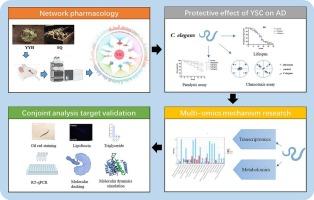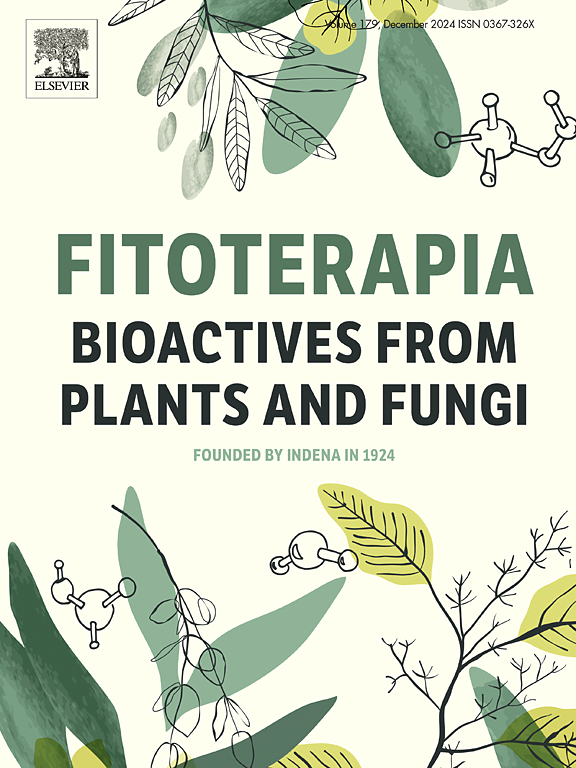Yanghuo Sanqi capsule against Alzheimer's disease by upregulating lipid metabolism: Network pharmacology and multi-omics analysis
IF 2.6
3区 医学
Q3 CHEMISTRY, MEDICINAL
引用次数: 0
Abstract
Yanghuo Sanqi capsule (YSC) consists of Yingyanghuo (Epimedium brevicornu Maxim., YYH) and Sanqi (Panax notoginseng (Burk.) F.H.Chen, SQ), which is used to treat cardiovascular diseases in Traditional Chinese Medicine (TCM). Additionally, the accumulated evidence suggests that it has the potential to treat Alzheimer's disease (AD). This study tries to elucidate the mechanisms of YSC against AD by combining network pharmacology of absorbed components with multi-omics of Caenorhabditis elegans (C. elegans). Firstly, network pharmacology was used to predict the target of the YSC in the treatment of AD. Then, Caenorhabditis elegans (C. elegans) CL4176 and CL2355 were used to study the effect of YSC on AD, and the mechanism was studied through multi-omics. Finally, potential therapeutic targets and bioactivity ingredients were identified through validation experiments, molecular docking, and molecular dynamics simulation. The network pharmacology of 15 mice blood components suggested that YSC may intervene in AD by regulating lipid metabolism and amyloid precursor protein (APP). In addition, YSC can alleviate Aβ-induced toxicity in both muscle and nerve in C. elegans. Transcriptomic and metabolomic analysis in C. elegans showed that YSC protected against AD by increasing lipid metabolism, which can maintain lipid homeostasis inside and outside the cell and down-regulating APP to alleviate Aβ-induced toxicity. Anhydroicaritin (AHI) is an important bioactive ingredient involved in regulating APP error clipping and lipid metabolism in YSC. This study reveals the mechanism of YSC anti-AD and provides experimental support for expanding its clinical use.

养火三七胶囊通过上调脂质代谢抗阿尔茨海默病:网络药理学和多组学分析
阳火三七胶囊(YSC)由阳火(淫羊藿)组成。三七(Panax notoginseng);陈富辉,SQ),在中医中用于治疗心血管疾病。此外,积累的证据表明,它具有治疗阿尔茨海默病(AD)的潜力。本研究试图结合秀丽隐杆线虫(C. elegans)吸收成分的网络药理学,探讨YSC抗AD的作用机制。首先,利用网络药理学预测YSC治疗AD的靶点。然后利用秀丽隐杆线虫(C. elegans) CL4176和CL2355研究YSC对AD的影响,并通过多组学研究其作用机制。最后,通过验证实验、分子对接和分子动力学模拟,确定潜在的治疗靶点和生物活性成分。15种小鼠血液成分的网络药理学表明,YSC可能通过调节脂质代谢和淀粉样前体蛋白(APP)干预AD。此外,YSC还能减轻a β对秀丽隐杆线虫肌肉和神经的毒性。对秀丽隐杆线虫的转录组学和代谢组学分析表明,YSC通过增加脂质代谢,维持细胞内外脂质稳态,下调APP以减轻a β诱导的毒性,从而对AD具有保护作用。Anhydroicaritin (AHI)是一种重要的生物活性成分,参与调节YSC的APP错误剪切和脂质代谢。本研究揭示了YSC抗ad的作用机制,为扩大其临床应用提供实验支持。
本文章由计算机程序翻译,如有差异,请以英文原文为准。
求助全文
约1分钟内获得全文
求助全文
来源期刊

Fitoterapia
医学-药学
CiteScore
5.80
自引率
2.90%
发文量
198
审稿时长
1.5 months
期刊介绍:
Fitoterapia is a Journal dedicated to medicinal plants and to bioactive natural products of plant origin. It publishes original contributions in seven major areas:
1. Characterization of active ingredients of medicinal plants
2. Development of standardization method for bioactive plant extracts and natural products
3. Identification of bioactivity in plant extracts
4. Identification of targets and mechanism of activity of plant extracts
5. Production and genomic characterization of medicinal plants biomass
6. Chemistry and biochemistry of bioactive natural products of plant origin
7. Critical reviews of the historical, clinical and legal status of medicinal plants, and accounts on topical issues.
 求助内容:
求助内容: 应助结果提醒方式:
应助结果提醒方式:


